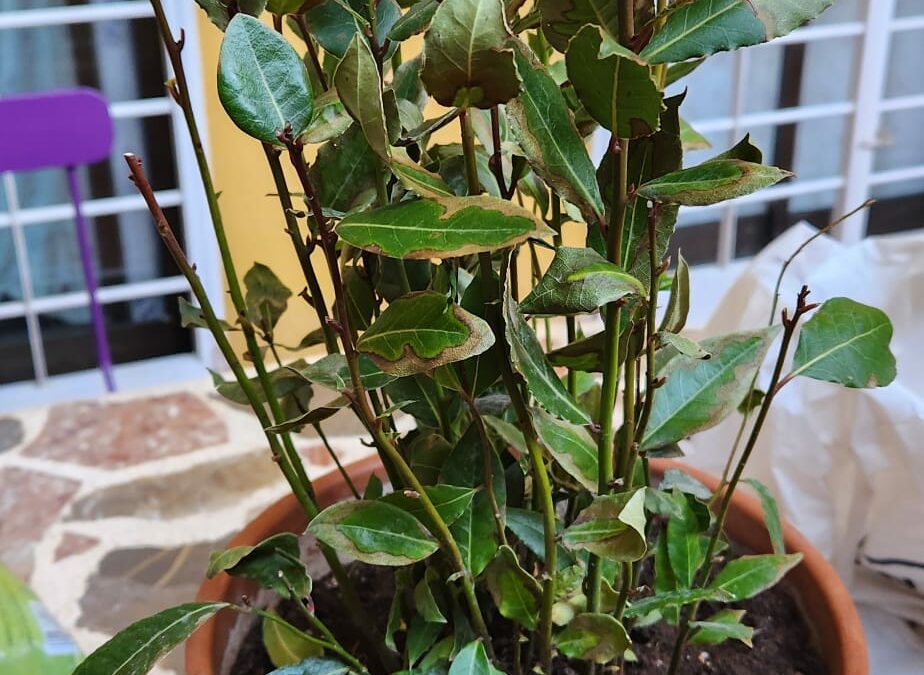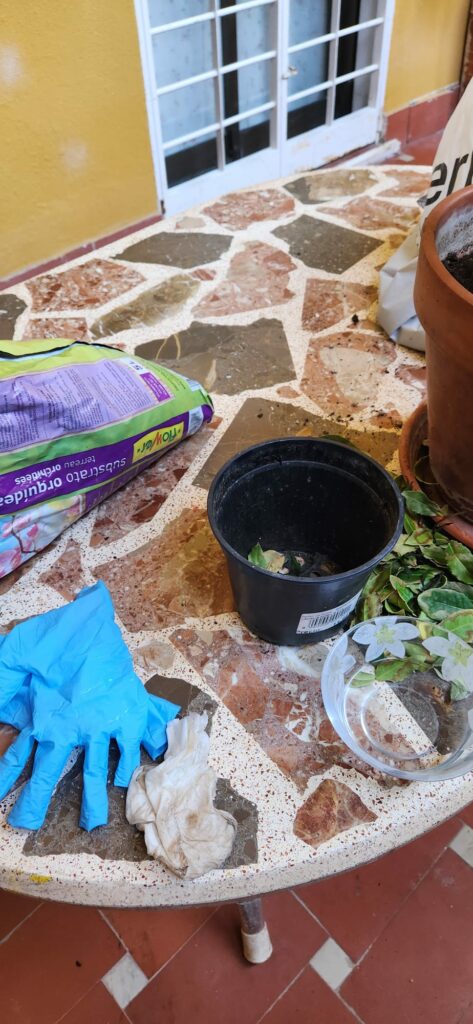My little sister has a tiny obsession with all things Ancient Greece at the moment. And in that spirit, she decided to buy herself a Hyacinth plant, in honour of Apollo. However, they didn’t have one at the garden centre! So, she went for a bay tree, which suits her well (bay is laurel in Spanish, and her name is Laura).
Problem is, the poor thing (the plant, not my sister!), only a few weeks later was looking quite dry. It was suffering, so my sister did what most of us tend to do, especially during the warm months: overwater. Leaves started turning brown and drying, but Malaga is quite warm in May, so my sister thought her bay tree was getting too much sun.
Enter: me. In 2020 I started learning about plants. I’m by no means an expert, but I can recognise overwatered plants and whenever one needs repotting. So, after removing it from its pot yesterday for the soil to dry, I spent an hour today repotting the little bay tree, trimming dead leaves and branches. And as I was cutting I remembered how much I used to love working with plants and how this would be a great topic for a blog post.
How to Know When to Repot a Plant
Repotting is one of those things that sounds more intimidating than it really is. I used to be terrified of doing it wrong—especially when the plant in question had survived longer than usual (a small miracle in my case). But the truth is, most houseplants are quite forgiving, and there are little signs they’ll give you when it’s time for a change.
If your plant is drooping even after watering, or if water rushes straight through the pot without soaking in, it might be rootbound. That’s when the roots have grown so tightly inside the pot that there’s barely any soil left. You might even see roots poking out the drainage holes or circling the surface.
Other signs? Yellowing leaves, stunted growth, and soil that dries out very quickly can all point to the need for a bigger pot and fresh soil.
How to Repot Plants Tips
-
Choose the right time – Spring and early summer are ideal. That’s when most plants are in their growing season, and they’ll recover from repotting more easily.
-
Pick the right pot – Aim for something just one size up from the current pot. Too big, and the soil can hold too much water, leading to root rot.
-
Prep your plant – Water it lightly a day before repotting. It makes the whole process less traumatic for the roots.
-
Loosen the roots – Gently tease them apart, especially if they’re tightly wound. If they’re really dense, you can snip a few with clean scissors.
-
Use fresh potting mix – Ideally, something suitable for your type of plant (more on that below!). Never just reuse the old tired soil without refreshing it.
-
Aftercare matters – Keep the plant out of direct sunlight for a few days after repotting to help it settle in.
Frequently Repotting Plants Questions
Should you water plants after repotting?
Yes… but gently. A light watering helps the soil settle around the roots. But as I said before, just avoid drowning it, especially if the plant has had a bit of root pruning. Overwatering right after repotting can sometimes shock the plant further.
How to fix root rot without repotting?
Tricky, but not impossible. If the rot isn’t too advanced, you can try trimming away affected leaves and letting the soil dry out completely before gently resuming a proper watering schedule. Adding cinnamon (yep, the kitchen kind!) to the soil can help with mild fungal issues. But to be honest, if there’s extensive root damage, repotting is usually the best fix.
Can you use old soil?
You can, but I wouldn’t recommend it. Old soil might be depleted of nutrients and could harbour pests or fungal spores. If you’re in a pinch, mix it with fresh potting mix and maybe a bit of compost – but ideally, go fresh where possible.
What soil to use when repotting indoor plants?
It depends on the plant! Most indoor plants do well in a general-purpose potting mix. But succulents and cacti need something gritty and fast-draining, while ferns and tropicals prefer a moisture-retentive mix. When in doubt, check the label or ask someone at your local garden centre.
Why is my plant dying after repotting?
It’s more common than you’d think, even when you do everything «right». Repotting can be a shock to a plant. If it’s drooping or losing leaves afterward, give it time. Keep it in indirect light, avoid overwatering, and resist the urge to fuss too much. It’s like moving house, sometimes you need a few days to adjust. Aftercare is really important, so keep reading to learn what to do after repotting your plants.
How much bigger should a pot be when repotting?
Roughly 2–5 cm (1–2 inches) wider in diameter than the old one is usually plenty. You want to give the roots a bit of breathing room, but not so much space that the plant feels like it’s swimming.
What to Do After Repotting a Plant
Repotting can feel like a bit of surgery: gentle but stressful for both your plant and you! Hence, once you have your plant snug in its new pot, the aftercare is just as important as the repotting itself.
1. Water, but not too much
Give the plant a light watering to help the new soil settle around the roots. But be careful not to drown it!! Especially if you’ve trimmed any roots, you want to avoid soggy conditions while the plant is healing. If you’re unsure, touch the soil first, as it should feel just slightly moist, not soggy.
2. Avoid direct sunlight for a bit
Your plant needs a bit of recovery time. Think of it like someone getting over a long journey: bright sun or dry air can be a bit much straight after repotting. Place your plant somewhere with soft, indirect light for at least a few days, or even a week, depending on the species.
3. Hold off on fertiliser
It can be tempting to give your plant a boost, but fertilising too soon after repotting can actually stress it out. Let the plant adjust to its new environment first and wait 3–4 weeks before feeding it again, especially if you’ve used fresh potting mix (which often already contains nutrients).
4. Don’t panic over drooping
Many plants will look a little sad right after being repotted, but don’t worry because this is quite normal, especially if roots were pruned or disturbed. A bit of wilting, yellowing, or leaf drop is totally normal. It’s always good to keep an eye on it, but try not to fuss. Just like us, plants need time to settle after a big change.
5. Check for drainage and airflow
Make sure excess water is draining properly. If water pools at the bottom or around the base, your plant could be sitting in soggy soil and that’s a recipe for root rot. That’s why a pot with a drainage hole is always best, but there are other ways to ensure drain. For instance, if you’re using a decorative outer pot with no hole, try placing the plant in a nursery pot inside it, so you can remove it when watering.
6. Keep an eye on new growth
The good news is, once your plant adjusts, it’ll often reward you with fresh leaves or new stems. That’s your sign that it’s happy in its new home! New growth might take a couple of weeks, just stay patient and consistent.
7. Talk to it. No, really!
Okay, optional… but I do it! I talk and sing to my plants when doing the repotting. Maybe it helps the plant, maybe it just helps me, but a little encouragement doesn’t hurt anyone. 😄


